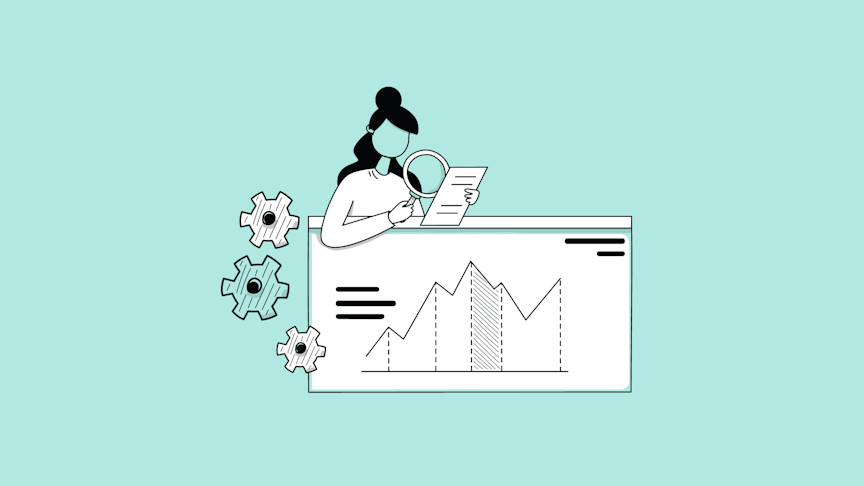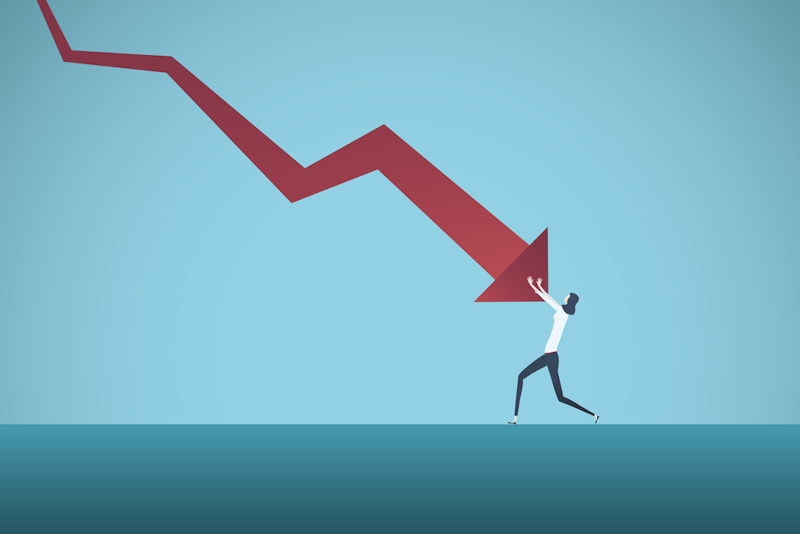Churn Rate vs Retention Rate
As a business owner, you need to understand churn rate and retention rate. These metrics show how well your products or services perform and give you insights into customer behavior.
This helps boost customer satisfaction and encourages repeat business.
Churn rate Churn rate shows the percentage of customers who leave your product during a specific time. .
Retention rate reflects the percentage of current customers who continue with your product.
For example, if you have 2,500 customers and 250 cancel their subscription, your monthly churn rate would be 10% and your retention rate 90%.
Churn Rate: (250 ÷ 2,500) × 100 = 10%Retention Rate: 100% - 10% = 90%
These metrics are crucial for business growth and profitability. Having a lower churn rate helps your business grow and boost your profits with minimal disruptions. A high retention rate means you spend less time looking for new customers, improving your overall cost-effectiveness.
In this guide, we'll explore:
When and how to use the metric
Measuring your churn rate and retention rate
Standard benchmarks for retention and churn and retention rates
Understanding these concepts will help you make informed decisions about your business strategies and customer relationships.
How to Calculate Churn Rate

Churn rate comes in two main types:
customer churn
Revenue churn.
Each type focuses on different aspects of company growth.
Let's examine these churn rates and learn how can calculate them.
Formula for Customer Churn Rate
To calculate churn rate, take the number of customers lost and divide it by the total customers at the beginning of the period. Then, multiply by 100 to get the churn percentage.
Example If your business had 500 users at the start of September and 100 left during the month, your customer churn rate can be calculated as (100/500) x 100 = 20%.
Customer churn rate = (Customers lost/churned during a given period / Total customers at the beginning of that period) x 100
Where Churned customers = (Customers at the beginning of the period - Customers remaining at the end) + New customers gained in that period
Most SaaS businesses should track their churn rate monthly or annually. For daily or weekly tracking, a cohort retention table works better.
What's an average Churn Rate?
After reviewing numerous data analyses, here's a breakdown of good churn rates for different business types
B2C SaaS : A monthly churn rate of 3-5% is considered good. Anything under 3% is excellent. Services charging less than $10 a month usually have lower churn.
Mid-Market B2B SaaS A churn rate up to 5% per month is acceptable. For companies with an ARPC(average revenue per customer) over $250 monthly, around 3% is better. Less than 2% is exceptional.
Early-stage B2B SaaS Expect monthly churn rates above 5% for fast-growing companies. Monitor trends and investigate if it doesn't decrease as you mature.
Enterprise B2B SaaS: A churn rate up to 2% per month is good. Anything below 1% is excellent. Larger businesses often change more slowly and tend to have annual billing.
Good retention rates: These are the reverse of churn rates. A 5% churn is equivalent to 95% retention rate.
Customer Retention Rate: What is it and How to Calculate it
Retention refers to the percentage of users who make repeat purchases within a specific time frame.
For SaaS companies, the business model centers on keeping customers long-term. This strategy increases monthly recurring revenue and boosts customer lifetime value.
How to Calculate Customer Retention Rate
The retention rate formula is simple.
Subtract the number of paying users at the end of a period from the number of new users acquired during that period. Divide this by the total users at the start of that specific time frame. Multiply by 100 to find the customer retention rate.
Example
Your company started June with 120 customers, lost 30, and gained 15 new ones. The retention rate would be:
((90 – 15) / 120) x 100 = 62.5%.
The basic formula is
The formula is:
Retention rate = (Customers at end of the period – New customers during the period) / Customers at start of the period x 100
For example, if you began the year with 150 customers, gained 40 new customers, and ended with 110, the retention rate would be:
((110 – 40) / 150) x 100 = 46.67%.
Retention tables help visualize this data and answer key questions
Which features do customers return to repeatedly?
Which features do customers try once and abandon?
What actions influence user retention or churn?
What traits do retained users have that churned users lack?
Answering these questions helps improve retention and reduce churn.
What's a Good Customer Retention Rate?
Good retention rates vary by industry and company growth stage.
Newer SaaS companies typically have lower retention rates. Established companies often reach average retention rates of 90%.
Research backs up these high retention figures, showing a 102% median net retention rate and a 91% median gross retention rate across SaaS businesses.
What's the Difference between Retention Rate and Churn Rate and Which One Should You Track?

Retention rate and Churn rate are closely related but represent opposite outcomes. Retention rate represents how many users stayed while churn rate measures the percentage of customers lost during a specific period.
Businesses strive for ideal numbers: 0% churn and 100% retention.
Both of these metrics offer valuable info about customer satisfaction. A high churn rate indicates dissatisfaction while a high retention rate suggests your customers are satisfied with the value you provide.
These metrics are crucial for developing effective customer strategies for success.
Key Differences
Churn rate shows lost customers
Retention rate highlights kept customers
Churn rate aims for 0%
Retention rate aims for 100%
Which to Track?
It's best to track both for comprehensive data. This approach gives you a complete picture of customer behavior and satisfaction.
By monitoring both metrics, you can
Identify trends in customer loyalty
Spot areas for improvement in your product or service
Make informed decisions about customer retention strategies
Tracking retention and churn rates together provides a balanced view of your business's customer relationships.
How to Understand Retention and Customer Churn Data?
Calculating retention and churn rates is only the first step—you need to interpret the data correctly to make it useful. This is where customer analytics steps in.
Here are ways to analyze churn and retention data:
Conduct Cohort Retention Analysis: What is it?
Cohort analysis helps you examine how different user groups interact with your product over time. Using retention tables with this analysis shows retention trends across multiple periods.
This approach helps you
Identify patterns in user behavior
Strengthen your retention strategy
Boost your retention rates
Cohort retention analysis highlights where and when retention drops or churn rates increase, enabling you to take proactive steps to improve these metrics.
Things You Need to Boost Retention
To track, analyze, and improve retention and reduce customer churn, you'll need
1. A way to identify new and current users (e.g., by job role and location, etc.)
2. A reliable analytics tool to analyze user behavior and track user churn.
3. Session recording to watch real product interactions
4. A method to test and validate improvements and new features
5. The ability to introduce new features safely to specific test groups and cohorts
6. Product-focused engineers or managers who communicate with users and work quickly
By using these tools and methods, you can gain deeper insights into your customer churn and retention data. This understanding allows you to make data-driven decisions to improve your product and keep more customers engaged long-term.
Wrapping Up
By tracking both retention and churn rates, you gain a comprehensive view of your customer relationships. This data helps you identify areas for improvement and develop strategies to keep customers engaged.
Remember, lower churn rates and higher retention rates typically indicate a healthy business. However, the ideal rates vary by industry and company stage.
To truly benefit from these metrics:
Regularly calculate and analyze your retention and churn rates
Use cohort analysis to uncover deeper insights
Implement the right tools and processes to track and boost these metrics
As you focus on improving your retention and churn rates, consider how AI-powered UX design can enhance your product experience. Our AI Design agency specializes in creating user-centric designs that boost customer satisfaction and loyalty.
Want to see how AI can transform your user experience and improve your retention rates? Book a free consultation with our UX experts today.
By prioritizing customer retention and leveraging advanced UX strategies, you're setting your business up for long-term success and sustainable growth.
FAQ’s
1. What does 5% churn mean?
A 5% churn rate means you're losing 5% of your customers over a specific period. For established businesses, aim for 5-7% annual churn or less than 1% monthly. Picture this: if you have 1,000 customers, you'd lose about 50 a year or 4-5 each month. Keep your churn low, and your business will thrive!
2. How do churn and retention rates differ?
Think of churn and retention as two sides of the same coin. Churn rate shows you how many customers wave goodbye, while retention rate tells you how many stick around. They're opposite measures of customer loyalty. Focus on boosting retention to naturally lower your churn.
3. What is the formula for churn rate?
Here's a simple churn rate formula: divide lost customers by total customers at the start, then multiply by 100. Let's say you started with 250 customers and lost 10. That's 10 divided by 250, which gives you 0.04. Multiply by 100, and voila! Your churn rate is 4%.
4. How do you calculate retention rate?
Calculating retention rate is a breeze. Take the number of employees (or customers) at the end of a period, divide it by the number at the start, then multiply by 100. This gives you the percentage of people who are stuck around. It's a great way to measure how well you're keeping your team or customer base intact.
5. What is a 30-day retention rate?
To nail down your 30-day retention rate, focus on active users. Count how many users are still subscribed after 30 days, divide that by your total active users at the start, then multiply by 100. This percentage shows you how sticky your product is in the crucial first month. Higher is better!





